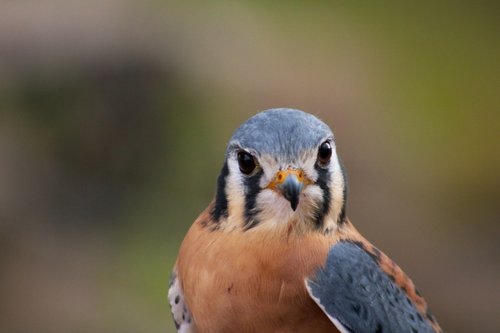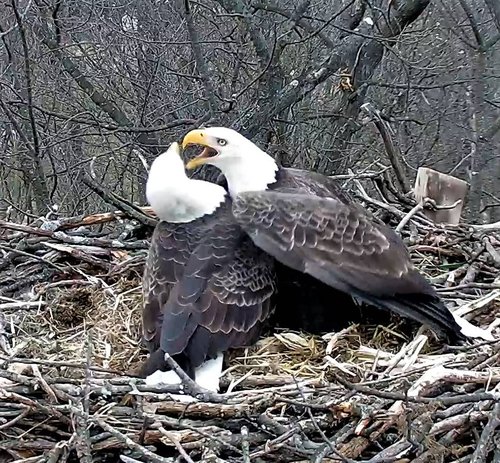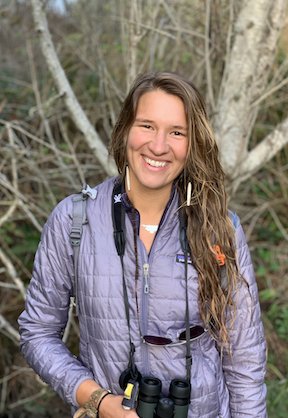Hanover Bald Eagle Blog # 4 - 2021
In partnership with Pennsylvania Game Commission and Comcast Business .
Although the Hanover pair is wing-deep in pre-nesting activities, many other birds haven’t even begun their return flight from far-flung winter getaways. The particularities of bald eagle breeding schedules are linked to the species’ breeding phenology, meaning the timing of their life history processes. As mentioned in our previous blog on chronology, the initiation dates of courtship, egg laying, fledging, and other breeding milestones are directly linked to the time required for a bald eagle chick to grow up.
Oftentimes bald eagles find themselves incubating while covered in snow! The Hanover eagles found themselves incubating under heavy snow in 2015 as seen above.
Bald eagles, great-horned owls, and barred owls are examples of raptor species that initiate their breeding season earlier than many other raptor groups in Pennsylvania, including falcons, harriers, ospreys, accipiters, and most buteos (definitions of the last two raptor groups located at the end of this blog). For example, American kestrels, small colorful falcons, typically lay their eggs in late April or early May (Dr. JF Therrien, personal communication, January 15, 2021). By this time, the Hanover nestlings would already be sporting feathers and stumbling around with eyes wide open.
One long-standing hypotheses as to why bald eagles breed early in the year is that the offspring of larger raptors need more time to develop. Timing of breeding is further defined by what a species eats. Perhaps most importantly, all bird parents time their breeding schedule so that their chicks will have access to high quality food when they need it most; during rapid stages of growth. Many migratory songbirds, for example, time their return to Pennsylvania so that there will be plenty of insect prey available while the chicks are developing in the nest. In turn, peregrine falcons match their phenology with that of waterfowl, songbirds, and shorebirds, which constitute the majority of their diet. It’s in the best interest of a peregrine parent to time their breeding cycle so that there are plenty of easy-to-catch, newly-fledged songbirds around when their falcon chicks need the most food, since young songbirds are easier to catch than adults.

Kestrel Photo by James Lee on Unsplash
Likewise, bald eagle breeding phenology corresponds with the availability of nutritious plump fish, so that when the chicks are in peak phase of structural and feather growth, roughly 35 days after hatching, they will have plenty to eat.
From nest construction to dispersal of young, bald eagle breeding season lasts roughly 10 months. If the Hanover pair began nest construction in April like many other raptor species, they wouldn’t finish until around December, when there is less food available due to freezing and snow cover. However, bald eagle breeding phenology is geographically relative: in higher latitudes, like Alaska, bald eagles don’t begin breeding until early April. Different conditions, different story.

And to think, the Hanover pair times all of this without reminders, notifications, calendars, or journals reminding them of last year’s mistakes!
FUN FACT
The term accipiter refers to “quick, agile raptors of boreal forest, bayberry thicket, and backyard bird feeder,” as described in Hawks in Flight by Peter Dunne, David Sibley, and Clay Sutton. In the words of these three acclaimed birding pioneers, accipiters are “The Artful Dodgers.” Accipiters are known for their ability to catch and prey upon other birds. They possess short, rounded wings and comparatively long tails that allow them to maneuver through forests and thickets. Sharp-shinned hawks, Cooper’s hawks, and Northern goshawks are all accipiters.
Buteos, or “The Wind Masters,” are a “diverse group of medium-to-large hawks that excel in the art of soaring.” Most buteos have anatomical adaptations to allow for long-term soaring and taking advantage of thermal lifts and updrafts. Species in this group include red-tailed hawks, red-shouldered hawks, and broad-winged hawks.
SOURCES
The Center for Conservation Biology. (n.d.). “Bald Eagle Chick Development.”
https://ccbbirds.org/2011/04/30/bald-eagle-chick-development/
Dunne, Peter (1988). Hawks in Flight. Houghton Mifflin.
ATTENTION HANOVER EAGLE VIEWERS - We recognize that over the years this bald eagle pair has been named by the public and is commonly referred to as "Freedom" and "Liberty". While we understand that naming the eagles helps connect and distinguish the female from the male eagle, naming the pair introduces an element of domesticity to wild animals. In order to respect the eagles and focus on their natural history, we will refer to the female and male as such as per recommendations of the Pennsylvania Game Commission.

Raptor Ecology Specialist - Zoey Greenberg
RETURN TO HANOVER BALD EAGLE BLOGS
WATCH THE HANOVER BALD EAGLE LIVE CAMS
For over 20 years, HDOnTap has provided live streaming solutions to resorts, amusement parks, wildlife refuges and more. In addition to maintaining a network of over 400 live webcams, HDOnTap specializes in design and installation of remote, off-grid and otherwise challenging live streaming solutions. Contact press@hdontap.com for all media needs, including images and recordings.